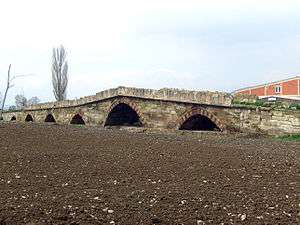Vojinović Bridge
Vojinović Bridge (Serbian: Војиновића мост/Vojinovića most; Albanian: Ura e Vjetër e Gurit, "Old stone bridge") is located in Vučitrn, Kosovo[a]. It dates from the end of the 14th or early 15th century, and, according to popular legend, was built by the brothers Vojinović, mentioned in Serbian epic poetry as nephews of Tsar Dušan (King 1331 - 1346, tsar 1346 - 1355). It carried over the Sitnica river the trade route between Dubrovnik and Skopje and neighbouring parts of the Balkan Peninsula.
 Vojinovića Bridge overview | |
| Location | Vučitrn, Kosovo[a] |
|---|---|
| Designer | Vojinović brothers |
| Type | Bridge |
| Material | Stone |
| Length | 135 m |
| Width | 5 m |
| Beginning date | 14th century |
| Completion date | 15th century |
| Monument of Culture of Exceptional Importance, | |
Despite the need, no conservation works were undertaken on the bridge,[1] and in 1990 it was declared as a Monument of Culture of Exceptional Importance by the Republic of Serbia.[1] It is regarded as the oldest surviving stone bridge in Serbia.[1]
History
The building of the bridge is traditionally attributed to the Vojinović brothers, to whom is also attributed the nearby Vučitrn Fortress, while its style places it at the end of the 14th or early 15th century. The Vojinovići existed as nobility in the first half of 14th century, and according to epic poetry were nephews of Emperor Dušan. However Vučitrn itself was outside their area of control, which was expanding to the nearby Zvečan, even at the time of their greatest power under the Vojislav Vojinović (around 1355 - 1363) and Nikola Altomanović (1366–1373). However, in Vučitrn in the early 15th century, the court of the house of Branković is mentioned, who were related to the Vojinović family: Ratoslava, the sister of Branko Mladenović (father of Vuk Branković) was married to Altoman Vojinović (father of Nikola Altomanović).
Architecture
The bridge carried the caravan route between Dubrovnik and Skopje across the river Sitnica. It is constructed of alternate red and grey trimmed stones. It is over 135 metres long with nine arches, and almost 5 metres wide. The arches are asymmetric, and most of them have a width of almost 13 metres. The course of the Sitnica changed over time: the bridge originally had 5 arches with sharp peaks, but 4 semicircular arches were subsequently added. The river continued to change its course over the centuries, and deposited sediment around the bridge, so that today it is no longer under the flowing river, and as a result of river sediment its total length has reduced.
Notes and references
Notes:
| a. | ^ Kosovo is the subject of a territorial dispute between the Republic of Kosovo and the Republic of Serbia. The Republic of Kosovo unilaterally declared independence on 17 February 2008, but Serbia continues to claim it as part of its own sovereign territory. The two governments began to normalise relations in 2013, as part of the 2013 Brussels Agreement. Kosovo is currently recognized as an independent state by 97 out of the 193 United Nations member states. In total, 112 UN member states recognized Kosovo at some point, of which 15 later withdrew their recognition. |
References:
See also
| Wikimedia Commons has media related to Ura e Vjetër e Gurit. |
- Monument of Culture of Exceptional Importance
- Vojinović Tower
- House of Vojinović
- Vučitrn
